Business Research for Hospitality: Leadership, Performance & Impact
VerifiedAdded on 2020/04/15
|23
|5949
|30
Report
AI Summary
This report examines the impact of participative leadership on employee performance within the hospitality industry, focusing on the Australian context. It begins by identifying the problem of poor employee performance and the need for effective leadership styles. The literature review explores participative leadership as an independent variable, discussing its characteristics, advantages, and relation to employee motivation, including McGregor's Theory X and Y. The dependent variable, employee performance, is defined, highlighting the importance of various factors that influence it. The interrelationship between participative leadership and employee performance is analyzed, emphasizing how participative leadership can enhance employee motivation, commitment, and overall performance. The research methodology includes the population, sampling technique, and ethical considerations. The report concludes with a discussion of limitations and provides a comprehensive reference list, offering valuable insights into the application of participative leadership within the hospitality sector.
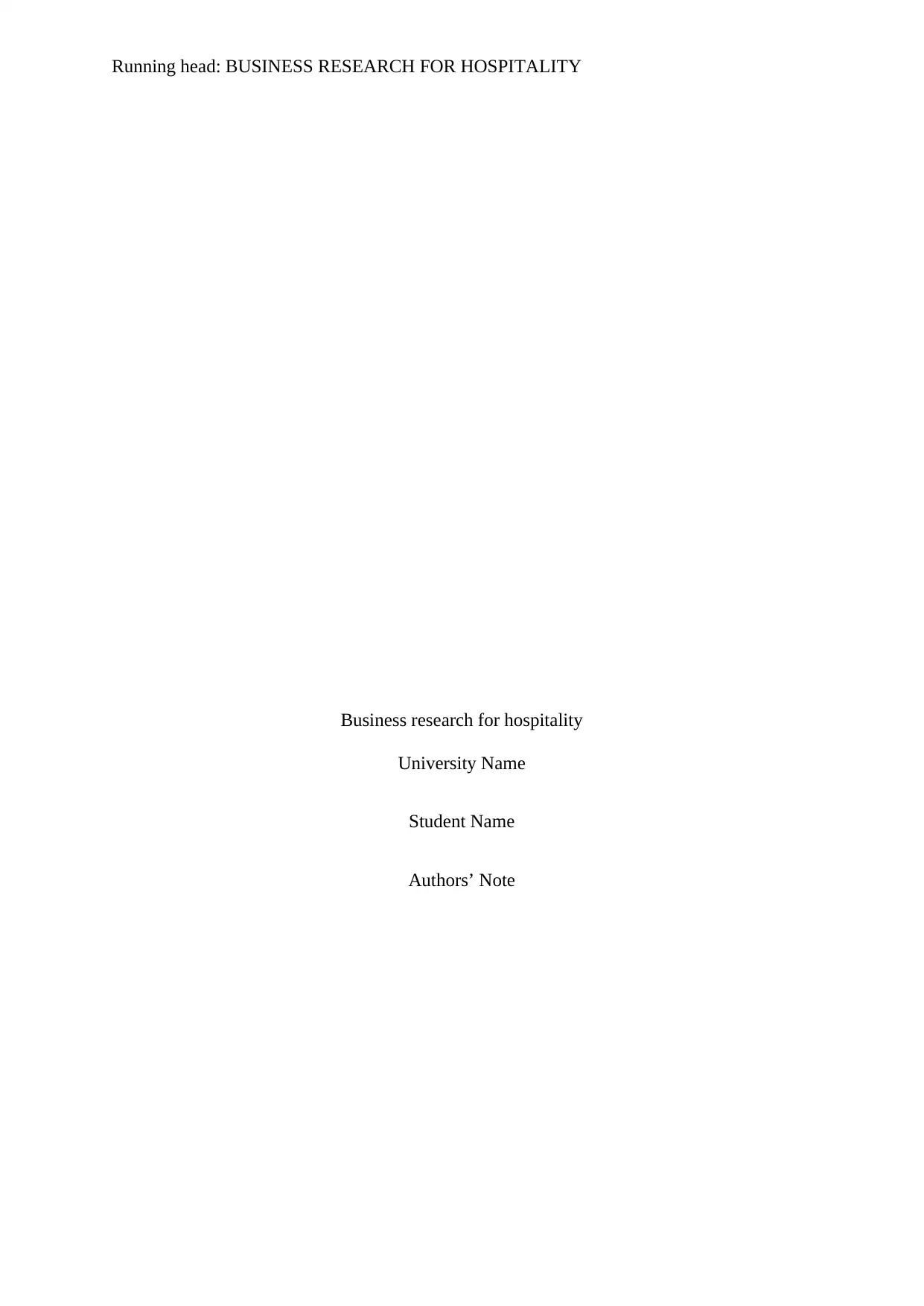
Running head: BUSINESS RESEARCH FOR HOSPITALITY
Business research for hospitality
University Name
Student Name
Authors’ Note
Business research for hospitality
University Name
Student Name
Authors’ Note
Paraphrase This Document
Need a fresh take? Get an instant paraphrase of this document with our AI Paraphraser
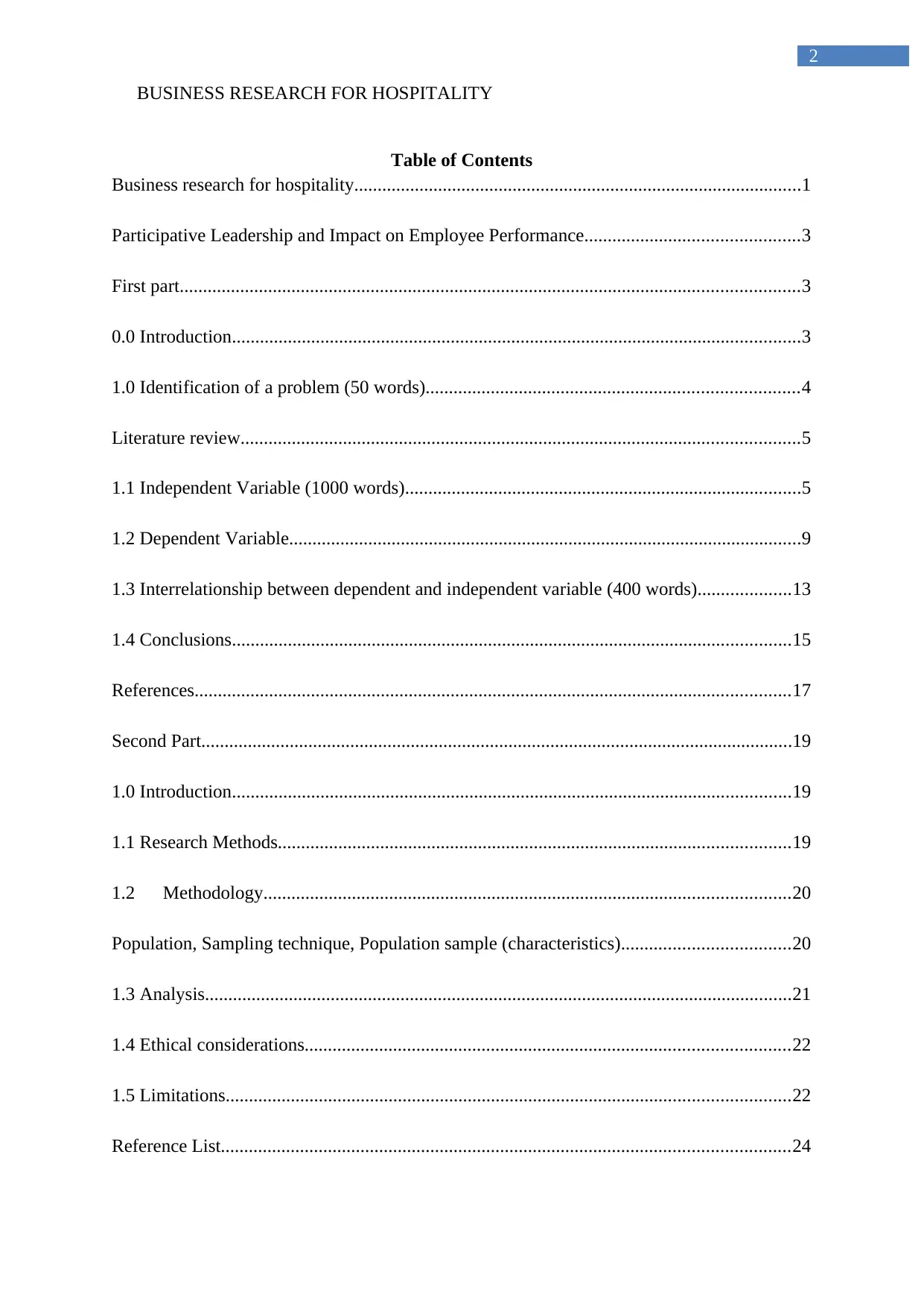
2
BUSINESS RESEARCH FOR HOSPITALITY
Table of Contents
Business research for hospitality................................................................................................1
Participative Leadership and Impact on Employee Performance..............................................3
First part.....................................................................................................................................3
0.0 Introduction..........................................................................................................................3
1.0 Identification of a problem (50 words)................................................................................4
Literature review........................................................................................................................5
1.1 Independent Variable (1000 words).....................................................................................5
1.2 Dependent Variable..............................................................................................................9
1.3 Interrelationship between dependent and independent variable (400 words)....................13
1.4 Conclusions........................................................................................................................15
References................................................................................................................................17
Second Part...............................................................................................................................19
1.0 Introduction........................................................................................................................19
1.1 Research Methods..............................................................................................................19
1.2 Methodology.................................................................................................................20
Population, Sampling technique, Population sample (characteristics)....................................20
1.3 Analysis..............................................................................................................................21
1.4 Ethical considerations........................................................................................................22
1.5 Limitations.........................................................................................................................22
Reference List..........................................................................................................................24
BUSINESS RESEARCH FOR HOSPITALITY
Table of Contents
Business research for hospitality................................................................................................1
Participative Leadership and Impact on Employee Performance..............................................3
First part.....................................................................................................................................3
0.0 Introduction..........................................................................................................................3
1.0 Identification of a problem (50 words)................................................................................4
Literature review........................................................................................................................5
1.1 Independent Variable (1000 words).....................................................................................5
1.2 Dependent Variable..............................................................................................................9
1.3 Interrelationship between dependent and independent variable (400 words)....................13
1.4 Conclusions........................................................................................................................15
References................................................................................................................................17
Second Part...............................................................................................................................19
1.0 Introduction........................................................................................................................19
1.1 Research Methods..............................................................................................................19
1.2 Methodology.................................................................................................................20
Population, Sampling technique, Population sample (characteristics)....................................20
1.3 Analysis..............................................................................................................................21
1.4 Ethical considerations........................................................................................................22
1.5 Limitations.........................................................................................................................22
Reference List..........................................................................................................................24
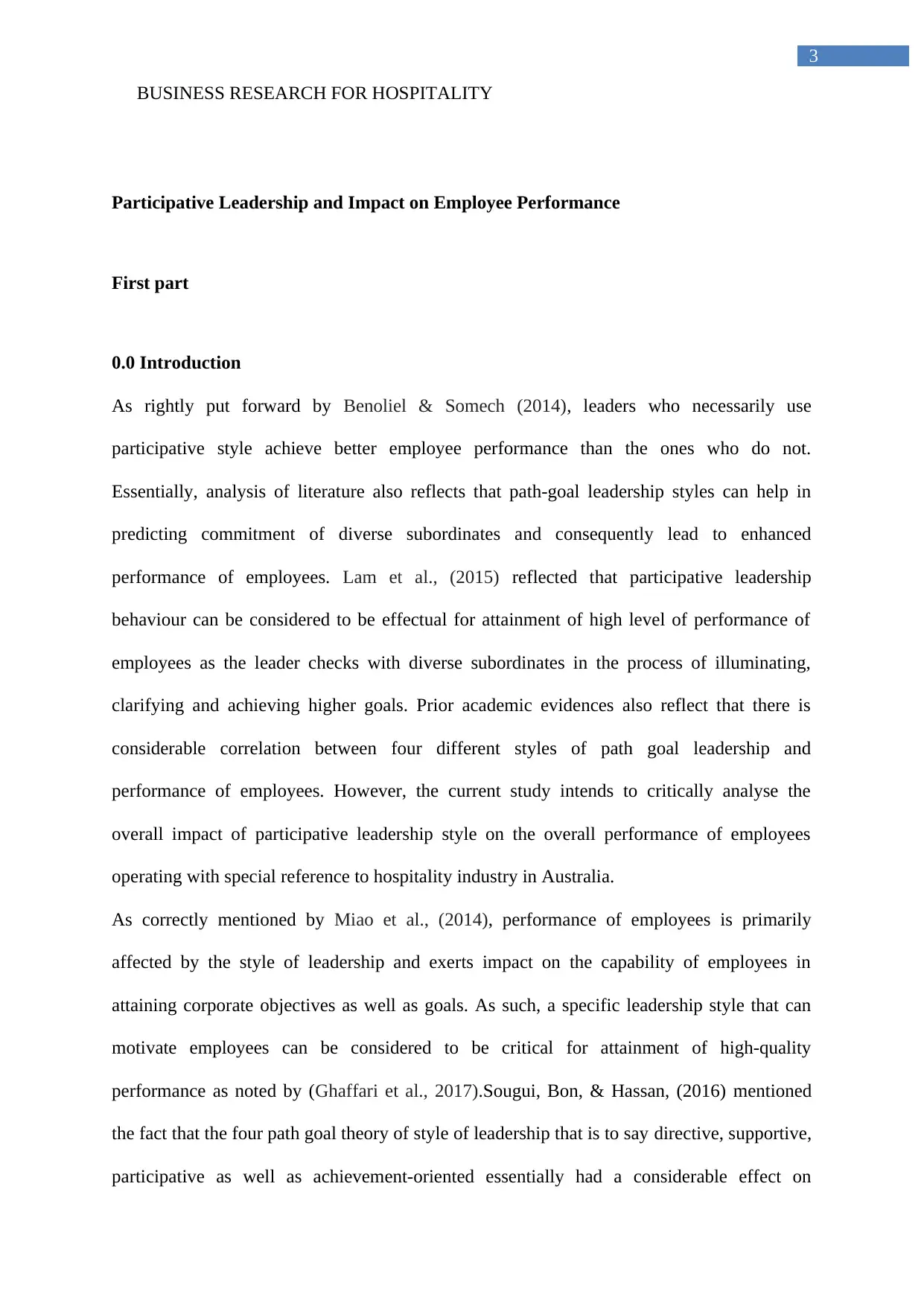
3
BUSINESS RESEARCH FOR HOSPITALITY
Participative Leadership and Impact on Employee Performance
First part
0.0 Introduction
As rightly put forward by Benoliel & Somech (2014), leaders who necessarily use
participative style achieve better employee performance than the ones who do not.
Essentially, analysis of literature also reflects that path-goal leadership styles can help in
predicting commitment of diverse subordinates and consequently lead to enhanced
performance of employees. Lam et al., (2015) reflected that participative leadership
behaviour can be considered to be effectual for attainment of high level of performance of
employees as the leader checks with diverse subordinates in the process of illuminating,
clarifying and achieving higher goals. Prior academic evidences also reflect that there is
considerable correlation between four different styles of path goal leadership and
performance of employees. However, the current study intends to critically analyse the
overall impact of participative leadership style on the overall performance of employees
operating with special reference to hospitality industry in Australia.
As correctly mentioned by Miao et al., (2014), performance of employees is primarily
affected by the style of leadership and exerts impact on the capability of employees in
attaining corporate objectives as well as goals. As such, a specific leadership style that can
motivate employees can be considered to be critical for attainment of high-quality
performance as noted by (Ghaffari et al., 2017).Sougui, Bon, & Hassan, (2016) mentioned
the fact that the four path goal theory of style of leadership that is to say directive, supportive,
participative as well as achievement-oriented essentially had a considerable effect on
BUSINESS RESEARCH FOR HOSPITALITY
Participative Leadership and Impact on Employee Performance
First part
0.0 Introduction
As rightly put forward by Benoliel & Somech (2014), leaders who necessarily use
participative style achieve better employee performance than the ones who do not.
Essentially, analysis of literature also reflects that path-goal leadership styles can help in
predicting commitment of diverse subordinates and consequently lead to enhanced
performance of employees. Lam et al., (2015) reflected that participative leadership
behaviour can be considered to be effectual for attainment of high level of performance of
employees as the leader checks with diverse subordinates in the process of illuminating,
clarifying and achieving higher goals. Prior academic evidences also reflect that there is
considerable correlation between four different styles of path goal leadership and
performance of employees. However, the current study intends to critically analyse the
overall impact of participative leadership style on the overall performance of employees
operating with special reference to hospitality industry in Australia.
As correctly mentioned by Miao et al., (2014), performance of employees is primarily
affected by the style of leadership and exerts impact on the capability of employees in
attaining corporate objectives as well as goals. As such, a specific leadership style that can
motivate employees can be considered to be critical for attainment of high-quality
performance as noted by (Ghaffari et al., 2017).Sougui, Bon, & Hassan, (2016) mentioned
the fact that the four path goal theory of style of leadership that is to say directive, supportive,
participative as well as achievement-oriented essentially had a considerable effect on
⊘ This is a preview!⊘
Do you want full access?
Subscribe today to unlock all pages.

Trusted by 1+ million students worldwide
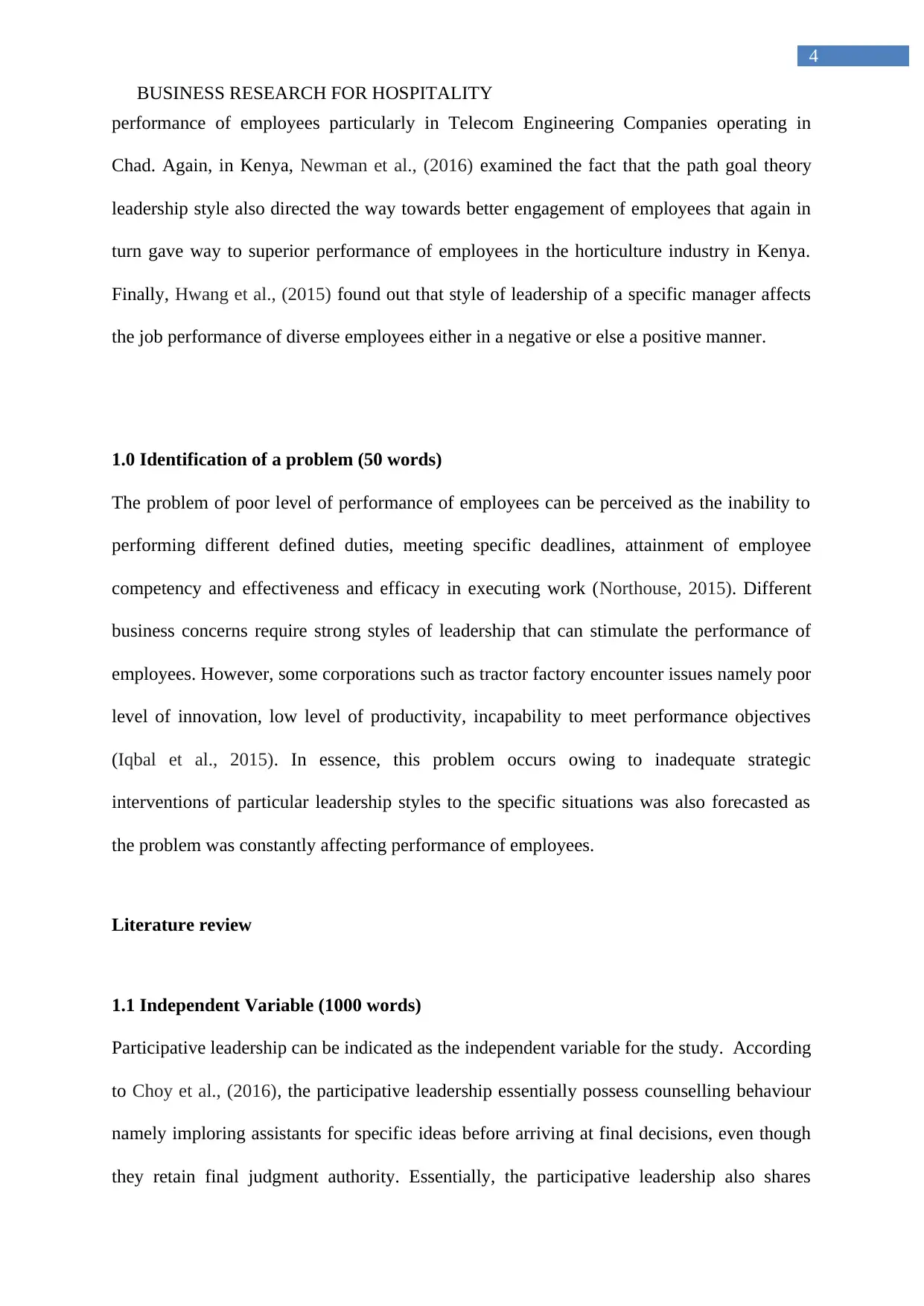
4
BUSINESS RESEARCH FOR HOSPITALITY
performance of employees particularly in Telecom Engineering Companies operating in
Chad. Again, in Kenya, Newman et al., (2016) examined the fact that the path goal theory
leadership style also directed the way towards better engagement of employees that again in
turn gave way to superior performance of employees in the horticulture industry in Kenya.
Finally, Hwang et al., (2015) found out that style of leadership of a specific manager affects
the job performance of diverse employees either in a negative or else a positive manner.
1.0 Identification of a problem (50 words)
The problem of poor level of performance of employees can be perceived as the inability to
performing different defined duties, meeting specific deadlines, attainment of employee
competency and effectiveness and efficacy in executing work (Northouse, 2015). Different
business concerns require strong styles of leadership that can stimulate the performance of
employees. However, some corporations such as tractor factory encounter issues namely poor
level of innovation, low level of productivity, incapability to meet performance objectives
(Iqbal et al., 2015). In essence, this problem occurs owing to inadequate strategic
interventions of particular leadership styles to the specific situations was also forecasted as
the problem was constantly affecting performance of employees.
Literature review
1.1 Independent Variable (1000 words)
Participative leadership can be indicated as the independent variable for the study. According
to Choy et al., (2016), the participative leadership essentially possess counselling behaviour
namely imploring assistants for specific ideas before arriving at final decisions, even though
they retain final judgment authority. Essentially, the participative leadership also shares
BUSINESS RESEARCH FOR HOSPITALITY
performance of employees particularly in Telecom Engineering Companies operating in
Chad. Again, in Kenya, Newman et al., (2016) examined the fact that the path goal theory
leadership style also directed the way towards better engagement of employees that again in
turn gave way to superior performance of employees in the horticulture industry in Kenya.
Finally, Hwang et al., (2015) found out that style of leadership of a specific manager affects
the job performance of diverse employees either in a negative or else a positive manner.
1.0 Identification of a problem (50 words)
The problem of poor level of performance of employees can be perceived as the inability to
performing different defined duties, meeting specific deadlines, attainment of employee
competency and effectiveness and efficacy in executing work (Northouse, 2015). Different
business concerns require strong styles of leadership that can stimulate the performance of
employees. However, some corporations such as tractor factory encounter issues namely poor
level of innovation, low level of productivity, incapability to meet performance objectives
(Iqbal et al., 2015). In essence, this problem occurs owing to inadequate strategic
interventions of particular leadership styles to the specific situations was also forecasted as
the problem was constantly affecting performance of employees.
Literature review
1.1 Independent Variable (1000 words)
Participative leadership can be indicated as the independent variable for the study. According
to Choy et al., (2016), the participative leadership essentially possess counselling behaviour
namely imploring assistants for specific ideas before arriving at final decisions, even though
they retain final judgment authority. Essentially, the participative leadership also shares
Paraphrase This Document
Need a fresh take? Get an instant paraphrase of this document with our AI Paraphraser
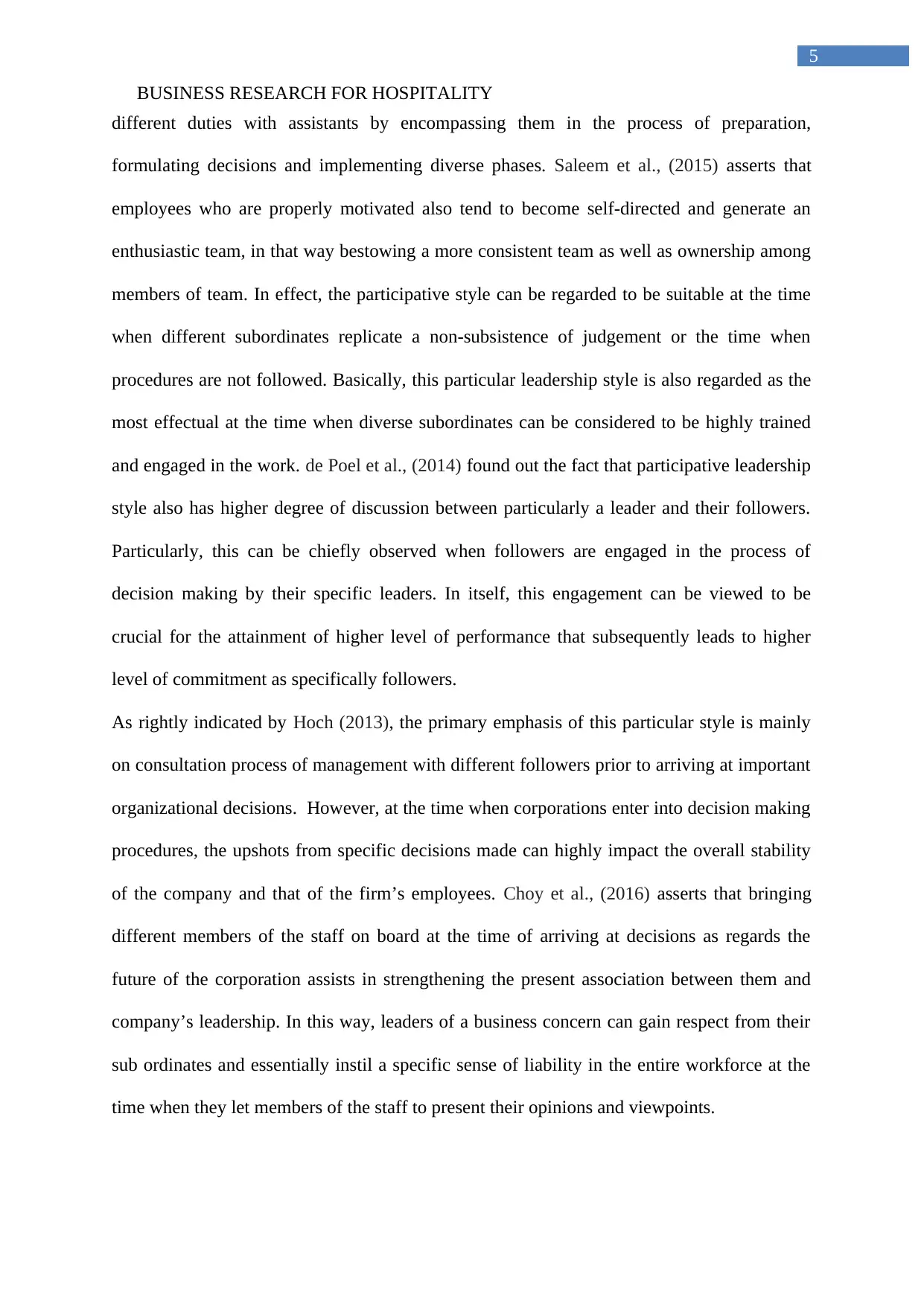
5
BUSINESS RESEARCH FOR HOSPITALITY
different duties with assistants by encompassing them in the process of preparation,
formulating decisions and implementing diverse phases. Saleem et al., (2015) asserts that
employees who are properly motivated also tend to become self-directed and generate an
enthusiastic team, in that way bestowing a more consistent team as well as ownership among
members of team. In effect, the participative style can be regarded to be suitable at the time
when different subordinates replicate a non-subsistence of judgement or the time when
procedures are not followed. Basically, this particular leadership style is also regarded as the
most effectual at the time when diverse subordinates can be considered to be highly trained
and engaged in the work. de Poel et al., (2014) found out the fact that participative leadership
style also has higher degree of discussion between particularly a leader and their followers.
Particularly, this can be chiefly observed when followers are engaged in the process of
decision making by their specific leaders. In itself, this engagement can be viewed to be
crucial for the attainment of higher level of performance that subsequently leads to higher
level of commitment as specifically followers.
As rightly indicated by Hoch (2013), the primary emphasis of this particular style is mainly
on consultation process of management with different followers prior to arriving at important
organizational decisions. However, at the time when corporations enter into decision making
procedures, the upshots from specific decisions made can highly impact the overall stability
of the company and that of the firm’s employees. Choy et al., (2016) asserts that bringing
different members of the staff on board at the time of arriving at decisions as regards the
future of the corporation assists in strengthening the present association between them and
company’s leadership. In this way, leaders of a business concern can gain respect from their
sub ordinates and essentially instil a specific sense of liability in the entire workforce at the
time when they let members of the staff to present their opinions and viewpoints.
BUSINESS RESEARCH FOR HOSPITALITY
different duties with assistants by encompassing them in the process of preparation,
formulating decisions and implementing diverse phases. Saleem et al., (2015) asserts that
employees who are properly motivated also tend to become self-directed and generate an
enthusiastic team, in that way bestowing a more consistent team as well as ownership among
members of team. In effect, the participative style can be regarded to be suitable at the time
when different subordinates replicate a non-subsistence of judgement or the time when
procedures are not followed. Basically, this particular leadership style is also regarded as the
most effectual at the time when diverse subordinates can be considered to be highly trained
and engaged in the work. de Poel et al., (2014) found out the fact that participative leadership
style also has higher degree of discussion between particularly a leader and their followers.
Particularly, this can be chiefly observed when followers are engaged in the process of
decision making by their specific leaders. In itself, this engagement can be viewed to be
crucial for the attainment of higher level of performance that subsequently leads to higher
level of commitment as specifically followers.
As rightly indicated by Hoch (2013), the primary emphasis of this particular style is mainly
on consultation process of management with different followers prior to arriving at important
organizational decisions. However, at the time when corporations enter into decision making
procedures, the upshots from specific decisions made can highly impact the overall stability
of the company and that of the firm’s employees. Choy et al., (2016) asserts that bringing
different members of the staff on board at the time of arriving at decisions as regards the
future of the corporation assists in strengthening the present association between them and
company’s leadership. In this way, leaders of a business concern can gain respect from their
sub ordinates and essentially instil a specific sense of liability in the entire workforce at the
time when they let members of the staff to present their opinions and viewpoints.
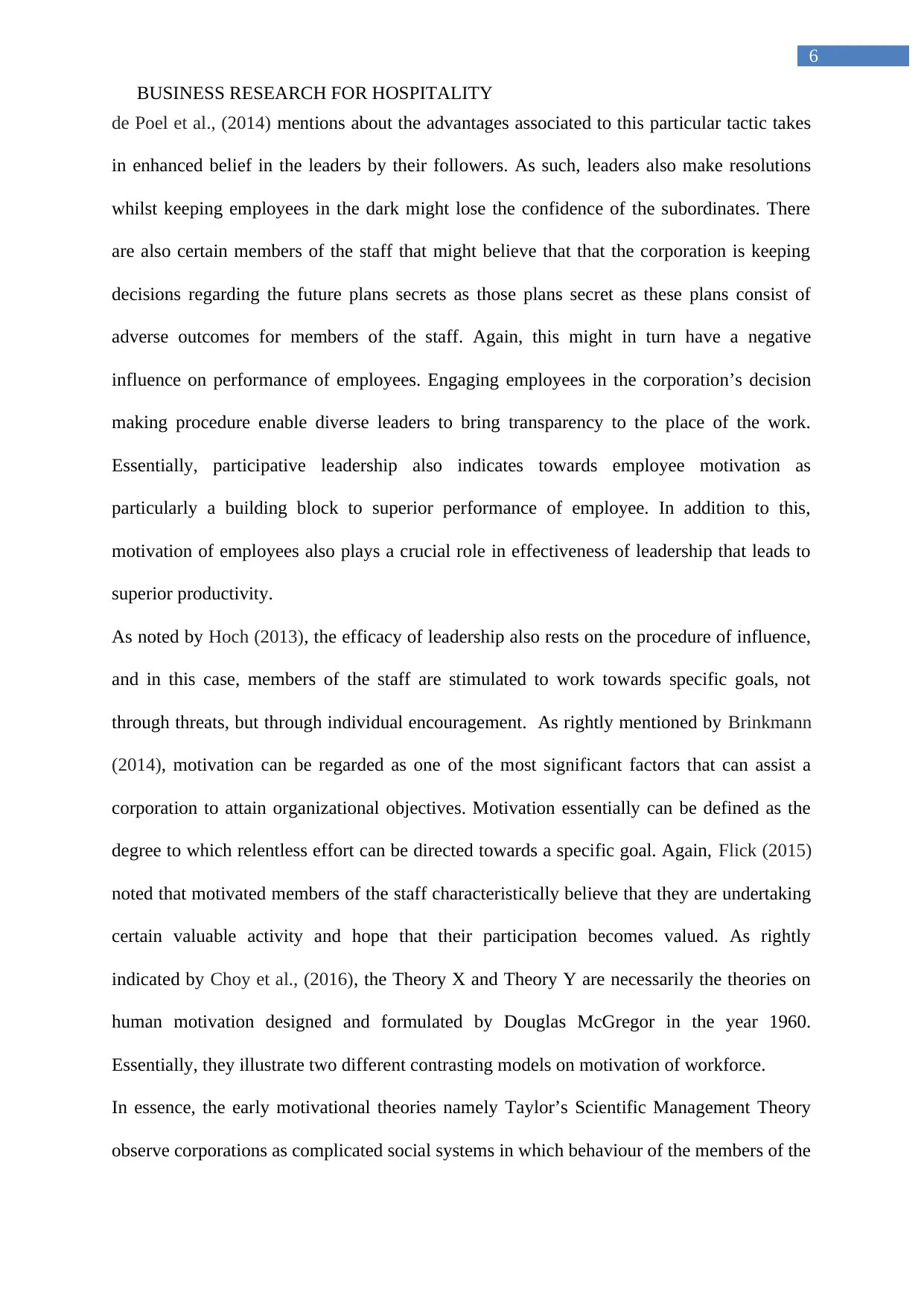
6
BUSINESS RESEARCH FOR HOSPITALITY
de Poel et al., (2014) mentions about the advantages associated to this particular tactic takes
in enhanced belief in the leaders by their followers. As such, leaders also make resolutions
whilst keeping employees in the dark might lose the confidence of the subordinates. There
are also certain members of the staff that might believe that that the corporation is keeping
decisions regarding the future plans secrets as those plans secret as these plans consist of
adverse outcomes for members of the staff. Again, this might in turn have a negative
influence on performance of employees. Engaging employees in the corporation’s decision
making procedure enable diverse leaders to bring transparency to the place of the work.
Essentially, participative leadership also indicates towards employee motivation as
particularly a building block to superior performance of employee. In addition to this,
motivation of employees also plays a crucial role in effectiveness of leadership that leads to
superior productivity.
As noted by Hoch (2013), the efficacy of leadership also rests on the procedure of influence,
and in this case, members of the staff are stimulated to work towards specific goals, not
through threats, but through individual encouragement. As rightly mentioned by Brinkmann
(2014), motivation can be regarded as one of the most significant factors that can assist a
corporation to attain organizational objectives. Motivation essentially can be defined as the
degree to which relentless effort can be directed towards a specific goal. Again, Flick (2015)
noted that motivated members of the staff characteristically believe that they are undertaking
certain valuable activity and hope that their participation becomes valued. As rightly
indicated by Choy et al., (2016), the Theory X and Theory Y are necessarily the theories on
human motivation designed and formulated by Douglas McGregor in the year 1960.
Essentially, they illustrate two different contrasting models on motivation of workforce.
In essence, the early motivational theories namely Taylor’s Scientific Management Theory
observe corporations as complicated social systems in which behaviour of the members of the
BUSINESS RESEARCH FOR HOSPITALITY
de Poel et al., (2014) mentions about the advantages associated to this particular tactic takes
in enhanced belief in the leaders by their followers. As such, leaders also make resolutions
whilst keeping employees in the dark might lose the confidence of the subordinates. There
are also certain members of the staff that might believe that that the corporation is keeping
decisions regarding the future plans secrets as those plans secret as these plans consist of
adverse outcomes for members of the staff. Again, this might in turn have a negative
influence on performance of employees. Engaging employees in the corporation’s decision
making procedure enable diverse leaders to bring transparency to the place of the work.
Essentially, participative leadership also indicates towards employee motivation as
particularly a building block to superior performance of employee. In addition to this,
motivation of employees also plays a crucial role in effectiveness of leadership that leads to
superior productivity.
As noted by Hoch (2013), the efficacy of leadership also rests on the procedure of influence,
and in this case, members of the staff are stimulated to work towards specific goals, not
through threats, but through individual encouragement. As rightly mentioned by Brinkmann
(2014), motivation can be regarded as one of the most significant factors that can assist a
corporation to attain organizational objectives. Motivation essentially can be defined as the
degree to which relentless effort can be directed towards a specific goal. Again, Flick (2015)
noted that motivated members of the staff characteristically believe that they are undertaking
certain valuable activity and hope that their participation becomes valued. As rightly
indicated by Choy et al., (2016), the Theory X and Theory Y are necessarily the theories on
human motivation designed and formulated by Douglas McGregor in the year 1960.
Essentially, they illustrate two different contrasting models on motivation of workforce.
In essence, the early motivational theories namely Taylor’s Scientific Management Theory
observe corporations as complicated social systems in which behaviour of the members of the
⊘ This is a preview!⊘
Do you want full access?
Subscribe today to unlock all pages.

Trusted by 1+ million students worldwide
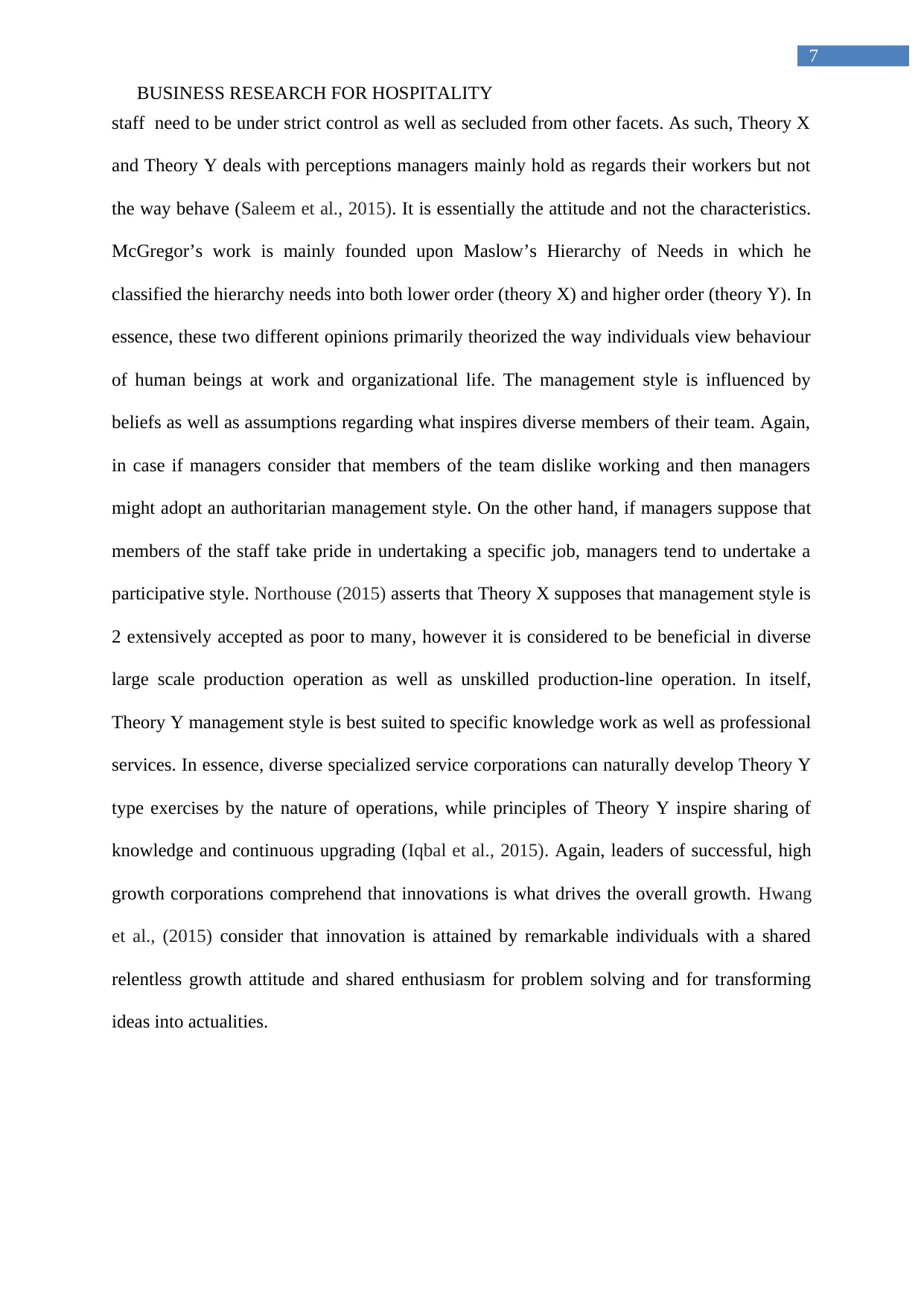
7
BUSINESS RESEARCH FOR HOSPITALITY
staff need to be under strict control as well as secluded from other facets. As such, Theory X
and Theory Y deals with perceptions managers mainly hold as regards their workers but not
the way behave (Saleem et al., 2015). It is essentially the attitude and not the characteristics.
McGregor’s work is mainly founded upon Maslow’s Hierarchy of Needs in which he
classified the hierarchy needs into both lower order (theory X) and higher order (theory Y). In
essence, these two different opinions primarily theorized the way individuals view behaviour
of human beings at work and organizational life. The management style is influenced by
beliefs as well as assumptions regarding what inspires diverse members of their team. Again,
in case if managers consider that members of the team dislike working and then managers
might adopt an authoritarian management style. On the other hand, if managers suppose that
members of the staff take pride in undertaking a specific job, managers tend to undertake a
participative style. Northouse (2015) asserts that Theory X supposes that management style is
2 extensively accepted as poor to many, however it is considered to be beneficial in diverse
large scale production operation as well as unskilled production-line operation. In itself,
Theory Y management style is best suited to specific knowledge work as well as professional
services. In essence, diverse specialized service corporations can naturally develop Theory Y
type exercises by the nature of operations, while principles of Theory Y inspire sharing of
knowledge and continuous upgrading (Iqbal et al., 2015). Again, leaders of successful, high
growth corporations comprehend that innovations is what drives the overall growth. Hwang
et al., (2015) consider that innovation is attained by remarkable individuals with a shared
relentless growth attitude and shared enthusiasm for problem solving and for transforming
ideas into actualities.
BUSINESS RESEARCH FOR HOSPITALITY
staff need to be under strict control as well as secluded from other facets. As such, Theory X
and Theory Y deals with perceptions managers mainly hold as regards their workers but not
the way behave (Saleem et al., 2015). It is essentially the attitude and not the characteristics.
McGregor’s work is mainly founded upon Maslow’s Hierarchy of Needs in which he
classified the hierarchy needs into both lower order (theory X) and higher order (theory Y). In
essence, these two different opinions primarily theorized the way individuals view behaviour
of human beings at work and organizational life. The management style is influenced by
beliefs as well as assumptions regarding what inspires diverse members of their team. Again,
in case if managers consider that members of the team dislike working and then managers
might adopt an authoritarian management style. On the other hand, if managers suppose that
members of the staff take pride in undertaking a specific job, managers tend to undertake a
participative style. Northouse (2015) asserts that Theory X supposes that management style is
2 extensively accepted as poor to many, however it is considered to be beneficial in diverse
large scale production operation as well as unskilled production-line operation. In itself,
Theory Y management style is best suited to specific knowledge work as well as professional
services. In essence, diverse specialized service corporations can naturally develop Theory Y
type exercises by the nature of operations, while principles of Theory Y inspire sharing of
knowledge and continuous upgrading (Iqbal et al., 2015). Again, leaders of successful, high
growth corporations comprehend that innovations is what drives the overall growth. Hwang
et al., (2015) consider that innovation is attained by remarkable individuals with a shared
relentless growth attitude and shared enthusiasm for problem solving and for transforming
ideas into actualities.
Paraphrase This Document
Need a fresh take? Get an instant paraphrase of this document with our AI Paraphraser
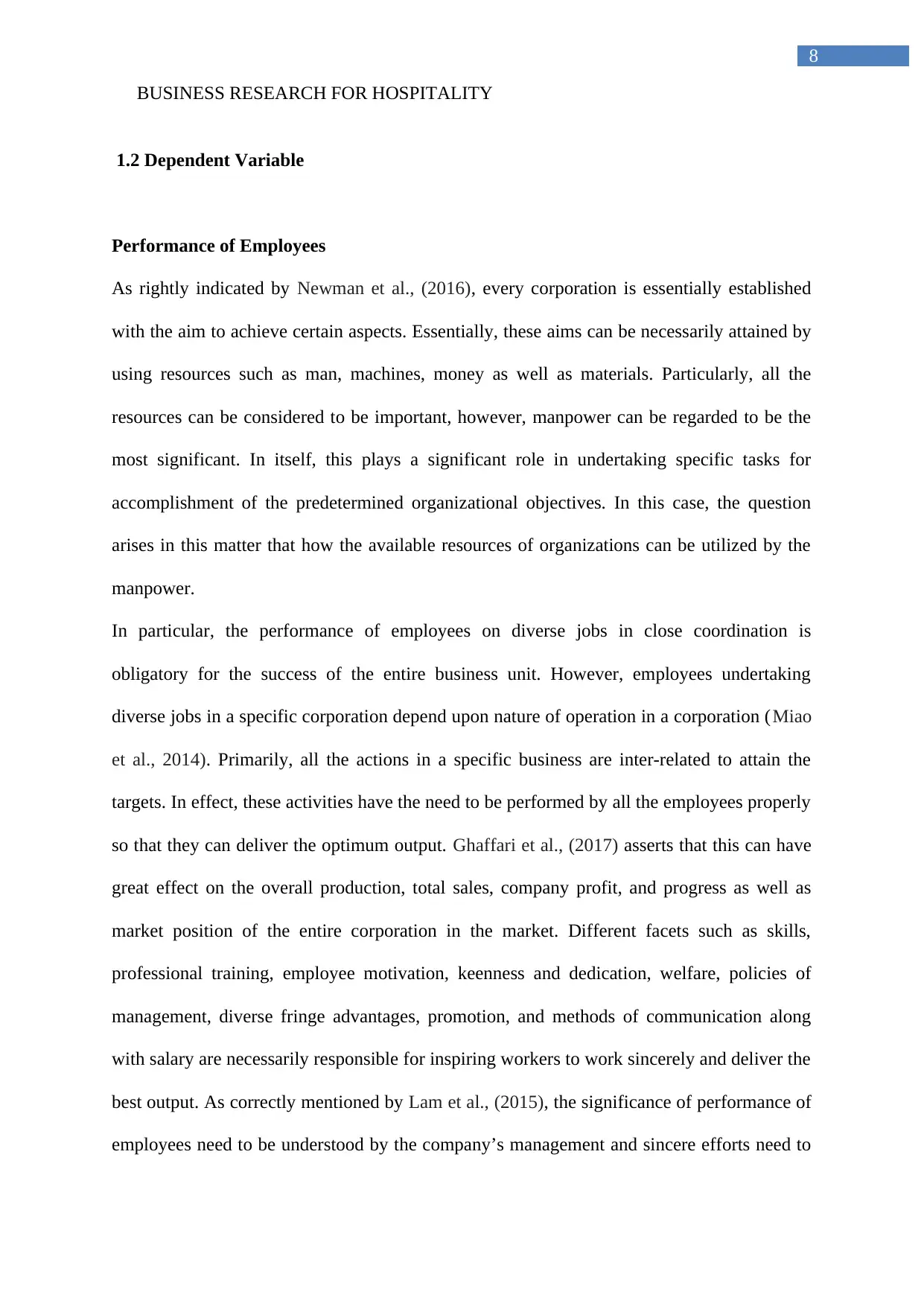
8
BUSINESS RESEARCH FOR HOSPITALITY
1.2 Dependent Variable
Performance of Employees
As rightly indicated by Newman et al., (2016), every corporation is essentially established
with the aim to achieve certain aspects. Essentially, these aims can be necessarily attained by
using resources such as man, machines, money as well as materials. Particularly, all the
resources can be considered to be important, however, manpower can be regarded to be the
most significant. In itself, this plays a significant role in undertaking specific tasks for
accomplishment of the predetermined organizational objectives. In this case, the question
arises in this matter that how the available resources of organizations can be utilized by the
manpower.
In particular, the performance of employees on diverse jobs in close coordination is
obligatory for the success of the entire business unit. However, employees undertaking
diverse jobs in a specific corporation depend upon nature of operation in a corporation (Miao
et al., 2014). Primarily, all the actions in a specific business are inter-related to attain the
targets. In effect, these activities have the need to be performed by all the employees properly
so that they can deliver the optimum output. Ghaffari et al., (2017) asserts that this can have
great effect on the overall production, total sales, company profit, and progress as well as
market position of the entire corporation in the market. Different facets such as skills,
professional training, employee motivation, keenness and dedication, welfare, policies of
management, diverse fringe advantages, promotion, and methods of communication along
with salary are necessarily responsible for inspiring workers to work sincerely and deliver the
best output. As correctly mentioned by Lam et al., (2015), the significance of performance of
employees need to be understood by the company’s management and sincere efforts need to
BUSINESS RESEARCH FOR HOSPITALITY
1.2 Dependent Variable
Performance of Employees
As rightly indicated by Newman et al., (2016), every corporation is essentially established
with the aim to achieve certain aspects. Essentially, these aims can be necessarily attained by
using resources such as man, machines, money as well as materials. Particularly, all the
resources can be considered to be important, however, manpower can be regarded to be the
most significant. In itself, this plays a significant role in undertaking specific tasks for
accomplishment of the predetermined organizational objectives. In this case, the question
arises in this matter that how the available resources of organizations can be utilized by the
manpower.
In particular, the performance of employees on diverse jobs in close coordination is
obligatory for the success of the entire business unit. However, employees undertaking
diverse jobs in a specific corporation depend upon nature of operation in a corporation (Miao
et al., 2014). Primarily, all the actions in a specific business are inter-related to attain the
targets. In effect, these activities have the need to be performed by all the employees properly
so that they can deliver the optimum output. Ghaffari et al., (2017) asserts that this can have
great effect on the overall production, total sales, company profit, and progress as well as
market position of the entire corporation in the market. Different facets such as skills,
professional training, employee motivation, keenness and dedication, welfare, policies of
management, diverse fringe advantages, promotion, and methods of communication along
with salary are necessarily responsible for inspiring workers to work sincerely and deliver the
best output. As correctly mentioned by Lam et al., (2015), the significance of performance of
employees need to be understood by the company’s management and sincere efforts need to
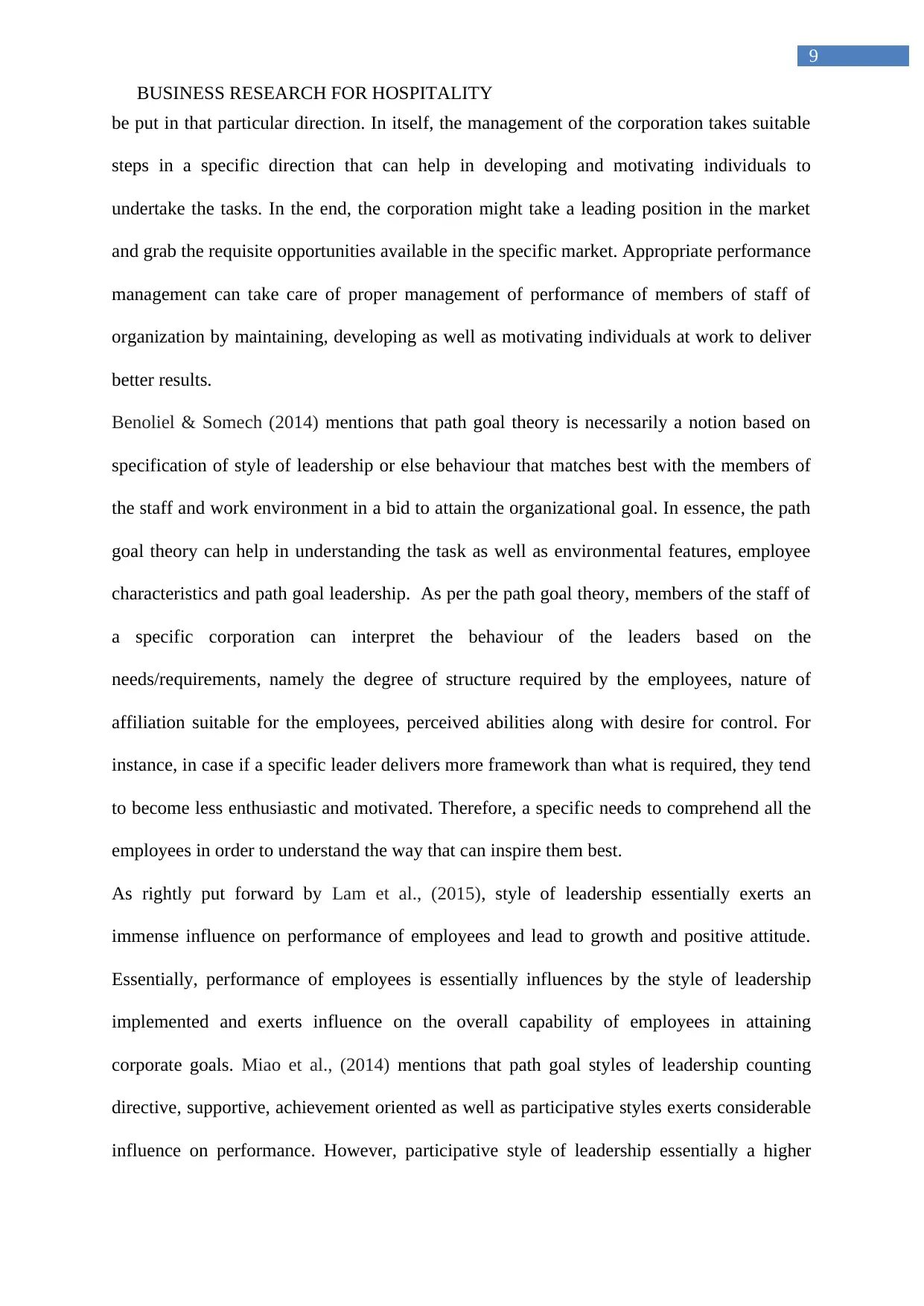
9
BUSINESS RESEARCH FOR HOSPITALITY
be put in that particular direction. In itself, the management of the corporation takes suitable
steps in a specific direction that can help in developing and motivating individuals to
undertake the tasks. In the end, the corporation might take a leading position in the market
and grab the requisite opportunities available in the specific market. Appropriate performance
management can take care of proper management of performance of members of staff of
organization by maintaining, developing as well as motivating individuals at work to deliver
better results.
Benoliel & Somech (2014) mentions that path goal theory is necessarily a notion based on
specification of style of leadership or else behaviour that matches best with the members of
the staff and work environment in a bid to attain the organizational goal. In essence, the path
goal theory can help in understanding the task as well as environmental features, employee
characteristics and path goal leadership. As per the path goal theory, members of the staff of
a specific corporation can interpret the behaviour of the leaders based on the
needs/requirements, namely the degree of structure required by the employees, nature of
affiliation suitable for the employees, perceived abilities along with desire for control. For
instance, in case if a specific leader delivers more framework than what is required, they tend
to become less enthusiastic and motivated. Therefore, a specific needs to comprehend all the
employees in order to understand the way that can inspire them best.
As rightly put forward by Lam et al., (2015), style of leadership essentially exerts an
immense influence on performance of employees and lead to growth and positive attitude.
Essentially, performance of employees is essentially influences by the style of leadership
implemented and exerts influence on the overall capability of employees in attaining
corporate goals. Miao et al., (2014) mentions that path goal styles of leadership counting
directive, supportive, achievement oriented as well as participative styles exerts considerable
influence on performance. However, participative style of leadership essentially a higher
BUSINESS RESEARCH FOR HOSPITALITY
be put in that particular direction. In itself, the management of the corporation takes suitable
steps in a specific direction that can help in developing and motivating individuals to
undertake the tasks. In the end, the corporation might take a leading position in the market
and grab the requisite opportunities available in the specific market. Appropriate performance
management can take care of proper management of performance of members of staff of
organization by maintaining, developing as well as motivating individuals at work to deliver
better results.
Benoliel & Somech (2014) mentions that path goal theory is necessarily a notion based on
specification of style of leadership or else behaviour that matches best with the members of
the staff and work environment in a bid to attain the organizational goal. In essence, the path
goal theory can help in understanding the task as well as environmental features, employee
characteristics and path goal leadership. As per the path goal theory, members of the staff of
a specific corporation can interpret the behaviour of the leaders based on the
needs/requirements, namely the degree of structure required by the employees, nature of
affiliation suitable for the employees, perceived abilities along with desire for control. For
instance, in case if a specific leader delivers more framework than what is required, they tend
to become less enthusiastic and motivated. Therefore, a specific needs to comprehend all the
employees in order to understand the way that can inspire them best.
As rightly put forward by Lam et al., (2015), style of leadership essentially exerts an
immense influence on performance of employees and lead to growth and positive attitude.
Essentially, performance of employees is essentially influences by the style of leadership
implemented and exerts influence on the overall capability of employees in attaining
corporate goals. Miao et al., (2014) mentions that path goal styles of leadership counting
directive, supportive, achievement oriented as well as participative styles exerts considerable
influence on performance. However, participative style of leadership essentially a higher
⊘ This is a preview!⊘
Do you want full access?
Subscribe today to unlock all pages.

Trusted by 1+ million students worldwide
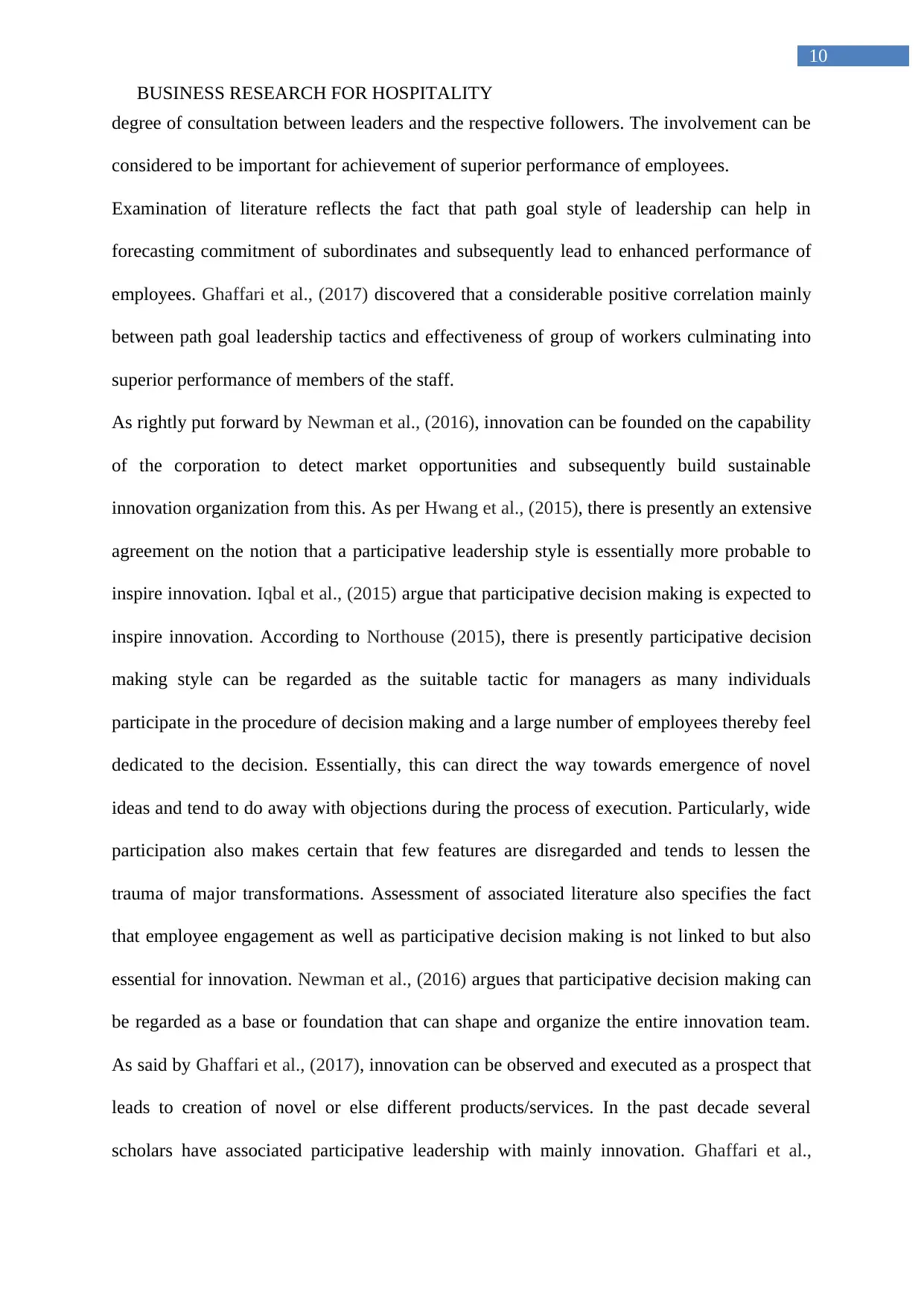
10
BUSINESS RESEARCH FOR HOSPITALITY
degree of consultation between leaders and the respective followers. The involvement can be
considered to be important for achievement of superior performance of employees.
Examination of literature reflects the fact that path goal style of leadership can help in
forecasting commitment of subordinates and subsequently lead to enhanced performance of
employees. Ghaffari et al., (2017) discovered that a considerable positive correlation mainly
between path goal leadership tactics and effectiveness of group of workers culminating into
superior performance of members of the staff.
As rightly put forward by Newman et al., (2016), innovation can be founded on the capability
of the corporation to detect market opportunities and subsequently build sustainable
innovation organization from this. As per Hwang et al., (2015), there is presently an extensive
agreement on the notion that a participative leadership style is essentially more probable to
inspire innovation. Iqbal et al., (2015) argue that participative decision making is expected to
inspire innovation. According to Northouse (2015), there is presently participative decision
making style can be regarded as the suitable tactic for managers as many individuals
participate in the procedure of decision making and a large number of employees thereby feel
dedicated to the decision. Essentially, this can direct the way towards emergence of novel
ideas and tend to do away with objections during the process of execution. Particularly, wide
participation also makes certain that few features are disregarded and tends to lessen the
trauma of major transformations. Assessment of associated literature also specifies the fact
that employee engagement as well as participative decision making is not linked to but also
essential for innovation. Newman et al., (2016) argues that participative decision making can
be regarded as a base or foundation that can shape and organize the entire innovation team.
As said by Ghaffari et al., (2017), innovation can be observed and executed as a prospect that
leads to creation of novel or else different products/services. In the past decade several
scholars have associated participative leadership with mainly innovation. Ghaffari et al.,
BUSINESS RESEARCH FOR HOSPITALITY
degree of consultation between leaders and the respective followers. The involvement can be
considered to be important for achievement of superior performance of employees.
Examination of literature reflects the fact that path goal style of leadership can help in
forecasting commitment of subordinates and subsequently lead to enhanced performance of
employees. Ghaffari et al., (2017) discovered that a considerable positive correlation mainly
between path goal leadership tactics and effectiveness of group of workers culminating into
superior performance of members of the staff.
As rightly put forward by Newman et al., (2016), innovation can be founded on the capability
of the corporation to detect market opportunities and subsequently build sustainable
innovation organization from this. As per Hwang et al., (2015), there is presently an extensive
agreement on the notion that a participative leadership style is essentially more probable to
inspire innovation. Iqbal et al., (2015) argue that participative decision making is expected to
inspire innovation. According to Northouse (2015), there is presently participative decision
making style can be regarded as the suitable tactic for managers as many individuals
participate in the procedure of decision making and a large number of employees thereby feel
dedicated to the decision. Essentially, this can direct the way towards emergence of novel
ideas and tend to do away with objections during the process of execution. Particularly, wide
participation also makes certain that few features are disregarded and tends to lessen the
trauma of major transformations. Assessment of associated literature also specifies the fact
that employee engagement as well as participative decision making is not linked to but also
essential for innovation. Newman et al., (2016) argues that participative decision making can
be regarded as a base or foundation that can shape and organize the entire innovation team.
As said by Ghaffari et al., (2017), innovation can be observed and executed as a prospect that
leads to creation of novel or else different products/services. In the past decade several
scholars have associated participative leadership with mainly innovation. Ghaffari et al.,
Paraphrase This Document
Need a fresh take? Get an instant paraphrase of this document with our AI Paraphraser
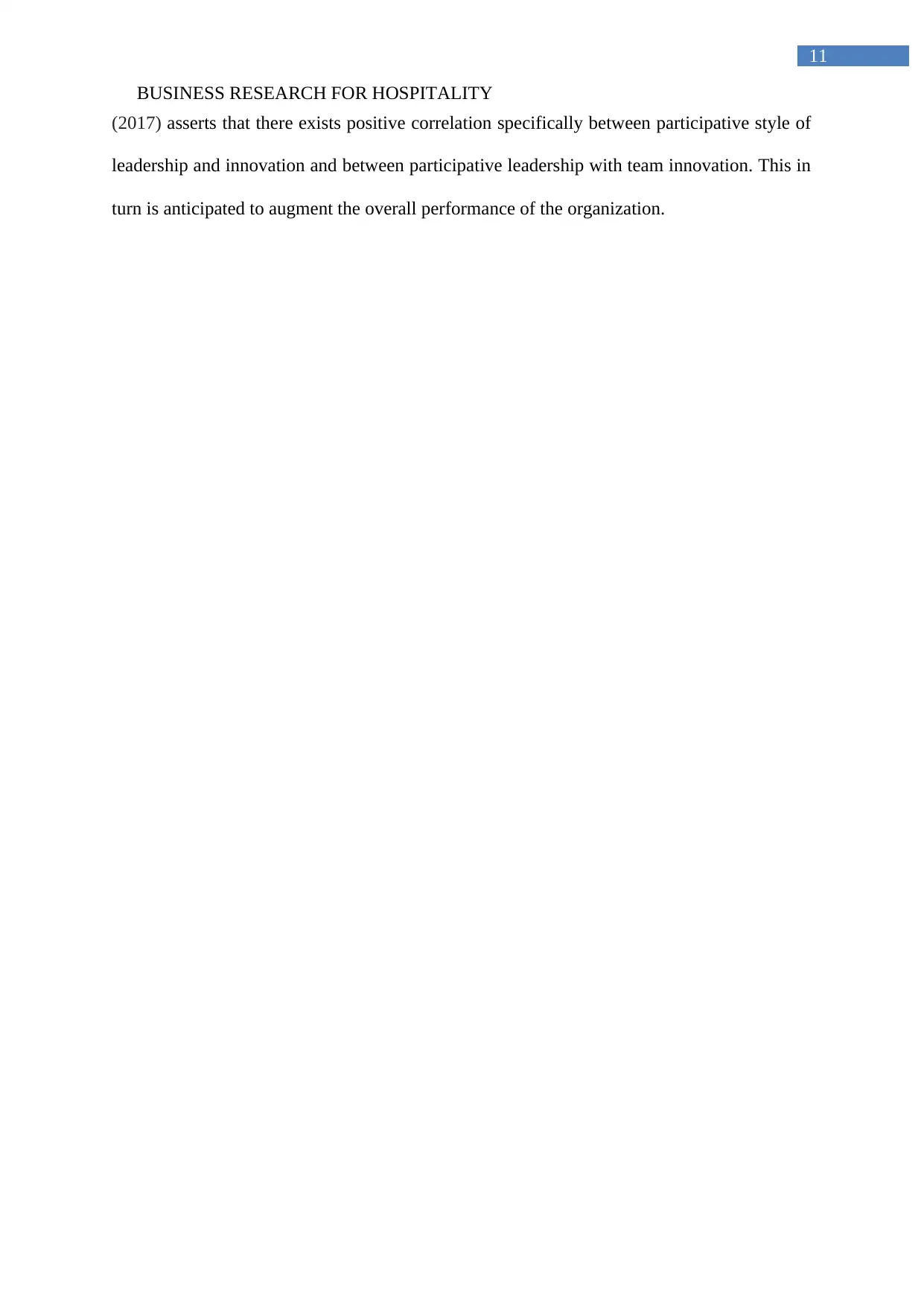
11
BUSINESS RESEARCH FOR HOSPITALITY
(2017) asserts that there exists positive correlation specifically between participative style of
leadership and innovation and between participative leadership with team innovation. This in
turn is anticipated to augment the overall performance of the organization.
BUSINESS RESEARCH FOR HOSPITALITY
(2017) asserts that there exists positive correlation specifically between participative style of
leadership and innovation and between participative leadership with team innovation. This in
turn is anticipated to augment the overall performance of the organization.
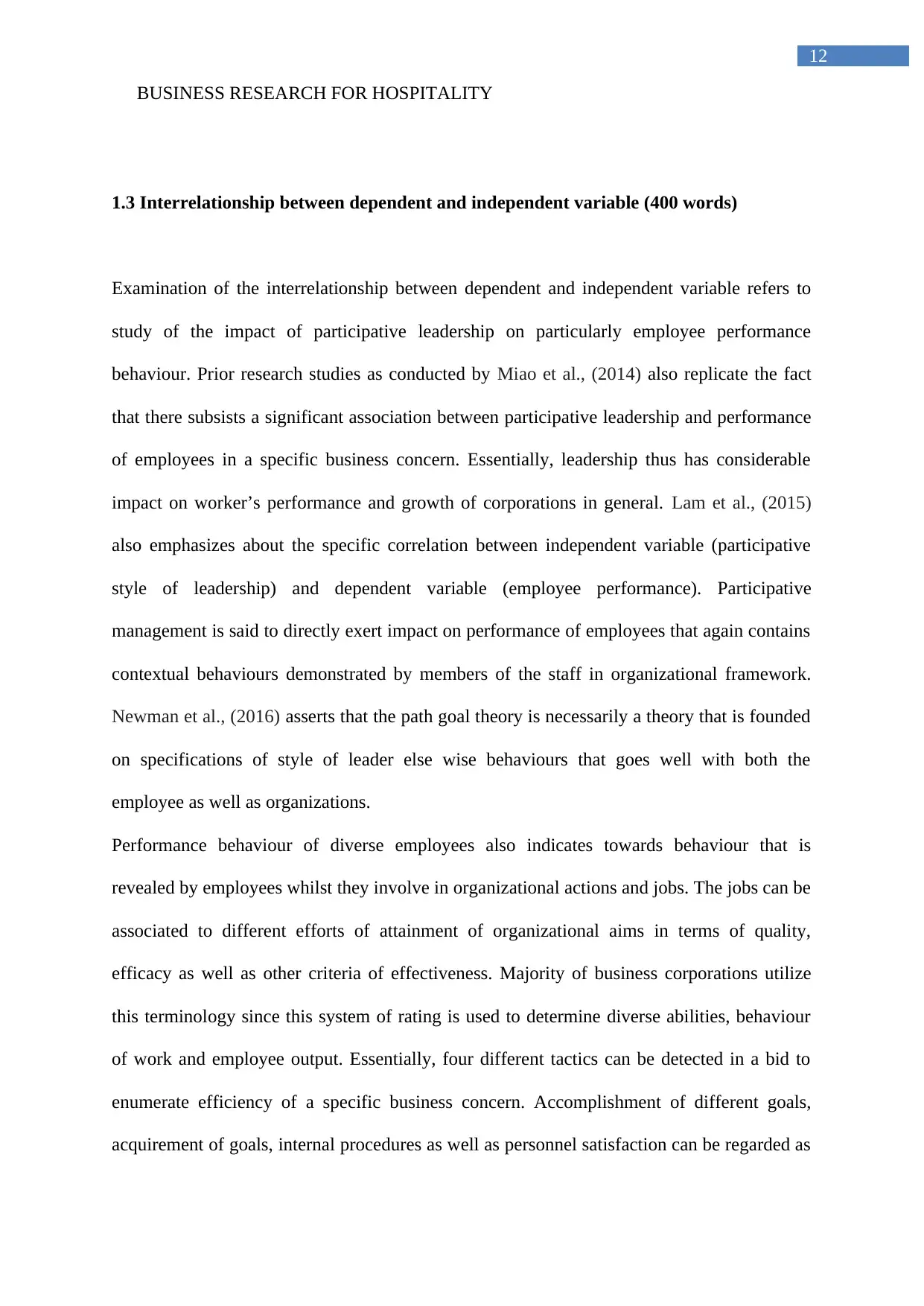
12
BUSINESS RESEARCH FOR HOSPITALITY
1.3 Interrelationship between dependent and independent variable (400 words)
Examination of the interrelationship between dependent and independent variable refers to
study of the impact of participative leadership on particularly employee performance
behaviour. Prior research studies as conducted by Miao et al., (2014) also replicate the fact
that there subsists a significant association between participative leadership and performance
of employees in a specific business concern. Essentially, leadership thus has considerable
impact on worker’s performance and growth of corporations in general. Lam et al., (2015)
also emphasizes about the specific correlation between independent variable (participative
style of leadership) and dependent variable (employee performance). Participative
management is said to directly exert impact on performance of employees that again contains
contextual behaviours demonstrated by members of the staff in organizational framework.
Newman et al., (2016) asserts that the path goal theory is necessarily a theory that is founded
on specifications of style of leader else wise behaviours that goes well with both the
employee as well as organizations.
Performance behaviour of diverse employees also indicates towards behaviour that is
revealed by employees whilst they involve in organizational actions and jobs. The jobs can be
associated to different efforts of attainment of organizational aims in terms of quality,
efficacy as well as other criteria of effectiveness. Majority of business corporations utilize
this terminology since this system of rating is used to determine diverse abilities, behaviour
of work and employee output. Essentially, four different tactics can be detected in a bid to
enumerate efficiency of a specific business concern. Accomplishment of different goals,
acquirement of goals, internal procedures as well as personnel satisfaction can be regarded as
BUSINESS RESEARCH FOR HOSPITALITY
1.3 Interrelationship between dependent and independent variable (400 words)
Examination of the interrelationship between dependent and independent variable refers to
study of the impact of participative leadership on particularly employee performance
behaviour. Prior research studies as conducted by Miao et al., (2014) also replicate the fact
that there subsists a significant association between participative leadership and performance
of employees in a specific business concern. Essentially, leadership thus has considerable
impact on worker’s performance and growth of corporations in general. Lam et al., (2015)
also emphasizes about the specific correlation between independent variable (participative
style of leadership) and dependent variable (employee performance). Participative
management is said to directly exert impact on performance of employees that again contains
contextual behaviours demonstrated by members of the staff in organizational framework.
Newman et al., (2016) asserts that the path goal theory is necessarily a theory that is founded
on specifications of style of leader else wise behaviours that goes well with both the
employee as well as organizations.
Performance behaviour of diverse employees also indicates towards behaviour that is
revealed by employees whilst they involve in organizational actions and jobs. The jobs can be
associated to different efforts of attainment of organizational aims in terms of quality,
efficacy as well as other criteria of effectiveness. Majority of business corporations utilize
this terminology since this system of rating is used to determine diverse abilities, behaviour
of work and employee output. Essentially, four different tactics can be detected in a bid to
enumerate efficiency of a specific business concern. Accomplishment of different goals,
acquirement of goals, internal procedures as well as personnel satisfaction can be regarded as
⊘ This is a preview!⊘
Do you want full access?
Subscribe today to unlock all pages.

Trusted by 1+ million students worldwide
1 out of 23
Related Documents
Your All-in-One AI-Powered Toolkit for Academic Success.
+13062052269
info@desklib.com
Available 24*7 on WhatsApp / Email
![[object Object]](/_next/static/media/star-bottom.7253800d.svg)
Unlock your academic potential
Copyright © 2020–2025 A2Z Services. All Rights Reserved. Developed and managed by ZUCOL.





